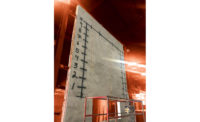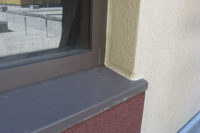Weather has a significant effect on the application requirements and nuances of plaster/stucco seasonally, and sometimes daily. Contributing factors are: temperature, humidity, wind and the exposure of the sun.
Every plasterer knows that plaster/stucco sets faster in the summer and slower in the winter. In this article the goal is to offer some helpful hints for the placement of plaster/stucco materials in both hot and cold conditions.
The cement used in plaster/stucco is hydraulic in nature, meaning the water mixed with the plaster is the catalyst for the chemical reaction that makes the material take on its initial set, get hard and subsequently cure. Hot weather poses a few challenges for plaster construction practices. As ambient temperatures rise and materials and equipment heat up during application, moisture evaporates more quickly therefore leaving less water for cement hydration. Losing the water too quickly can result in lower tensile strengths and cracking. ASTM C 926—Specification Standard for Application of Portland Cement Based Plaster requires wetting or fogging the wall between successive coats and for up to several days after the application to aid in the curing process. Heat, wind and humidity all play a big part in the limiting the curing process and if the wall has not received a sufficient amount of watering and “fogging” during this process, a wall with soft material and excessive cracking may result if the plaster has dried out too quickly.
HOT WEATHER
Hot weather is defined as ambient temperature exceeding 100 degrees Fahrenheit (37.8 degrees Celsius) or 90 degrees F (32.2 degrees C) with a wind velocity greater than 8 mph (12.9 km per hour). Compounding factors include low relative humidity and direct sunshine.
Below are some of the effects on the plaster:
- Workability is reduced
- More water is required for workability
- Initial and final set occur earlier
The result is that the plasterer can experience difficulty in placing and working the material. In addition to negatively affecting the workability, the rapid increase in drying time can result in a lack of sufficient water or proper hydration of the plaster. Inadequate hydration can result in a lack of strength development and contribute to the plaster cracking.
The following techniques should be followed during hot weather installations:
- Schedule construction to avoid hot midday periods.
- Work earlier during the cooler temperatures (“run from the sun”).
- Minimize exposure of materials and equipment to direct sunlight.
- Use cool water to mix.
- Use cool water on shovels and mud boards.
- Control amount of plaster spread so as to not get too far ahead of rodding/leveling wall surface
- Moist cure the plaster “fog the wall.”
- Protect the wall from uneven curing or exposure. Draping a tarp over the scaffold to shield the plaster during hot windy days is very effective.
Some other helpful hints for hot weather construction:
- Do not apply plaster/stucco to hot surfaces.
- Use plaster/stucco materials with optimal water retention, workability and consistency. Using a preblended plaster/stucco helps to achieve this and can be custom blended.
- Do not apply cementitious materials at temperatures above 100 degree F (37.8 degrees C) without preparations. Monitor the extended weather forecast during the installation and curing period for severe temperatures.
- Keep materials shaded to reduce temperatures upon installation.
COLD WEATHER
Plastering when the temperature is at or near freezing causes another set of problems for the contractor or installer. There are precautionary measures that can be taken to protect the project during cold adverse weather conditions. Extra care should be observed if the temperature is not at least 40 degrees F (4.4 degrees C) and rising, or if the temperature drops below 32 degrees F (0 degrees C) after the wall has been plastered.
The International Building Code for cement plastering requires in Section 2512 that “plaster coats shall be protected from freezing for a period of not less than 24 hours after initial set has occurred. Plaster shall be applied when the ambient temperature is higher than 40 degrees F (4.4 degrees C) unless provisions are made to keep cement plaster work above 40 degrees F (4.4 degrees C) during application and 48 hours thereafter.”
Similarly ACI 24, Guide to Cement Plastering, requires that, “Plaster installed when ambient temperatures are below 40 degrees F (4.4 degrees C) must be maintained in a sheltered and heated environment with continued curing to assure cement hydration.”
At 32 degrees F (0 degrees C) and below, plaster will freeze on the wall and cause weakening of the plaster. Damage to the plaster can be so severe that you can rub it off the wall by using your hand.
Cold dry air on the surface of the wall can absorb warm moisture from the wall rapidly and can lead to plastic shrinkage cracks. Low temperatures can cause all cement plaster to take longer than normal to set and gain strength which delays floating, trowelling and production which raises labor costs unnecessarily. If a wall has been frozen the resulting wall may have excessive porosity which can cause further deterioration during freeze thaw cycles if a driving rain hits it and it freezes. Cold conditions, as such, can also make the wall more susceptible to efflorescence forming on the surface of the wall. To counteract these cold weather problems several precautionary measures can be taken which may involve enclosing and heating the structure.
When the cooler weather approaches a contractor should plan in advance and budget for enclosing and heating the project if necessary. This will reduce the effect of cold weather on plastering/stucco projects and increase the likelihood of successful project completion in freezing weather.
When air temperatures start to fall towards the end of the year, special considerations/precautions need to be given to the installation/application of cement plaster/stucco. The application of cemetitious materials is typically restricted to temperature of 40 degrees F (4.4 degrees C) and rising. This minimum is critical to the proper curing and overall performance of the material. Application of materials in cold and freezing conditions can cause materials to crack, flake, soften and delaminate.
- Hydration of cement based materials is slower at cooler temperature.
- Set times of the material will be slower in cooler temperatures they may freeze or not set up at all.
- Strength development of the material can be reduced.
Thermal fluctuations will cause movement in the substrate which can produce cracking. Any crack in the substrate including joints between substrate components is subject to movement. Thermal cycling and therefore maximum movement is at its highest frequency during the fall months. Cracks that appear narrow in the warmth of the afternoon (when substrates are expanded) may widen significantly during the night when the temperature falls. This thermal movement can cause surface cracking. (In repair/restoration situations the cracking can be even more severe as the patching material that fills in and around existing material has not developed full strength.)
Some helpful hints:
- Do not apply plaster/stucco to frozen surfaces.
- Do not apply cementitious materials at temperatures below 40 degree Fahrenheit without monitoring weather conditions. Monitor the extended weather forecast during the installation and curing period for severe temperature drops.
- Keep materials stored at 45 degrees F (7.2 degrees C) or higher if possible.
- Tenting and enclosures may need to be utilized for the proper application under cold conditions to avoid freezing and if they are pay close attention to enclose the entire application area to properly withstand wind and rain.
- Adequate ventilation should be engineered into the enclosure for safety and to provide for proper air movement for curing. Avoid using gas, kerosene or other fossil fuel heaters because they can cause rapid carbonation of cementitious material during initial set and cure.
- The heated enclosed area also needs to have the heat source run long enough before and after the application for proper conditioning and cure times.
- The temperature of the substrate also needs to be taken into consideration. Heating the mixing water up to 120 degrees F (84.4 degrees C) (do not exceed 120) can offset the lower temperatures of the substrate/wall surface and plaster materials themselves. Using a pre-blended plaster/stucco eliminates the need to heat the sand and frozen sand piles.
- Reduce the amount of mixing water to the practical minimum to minimize shrinkage cracking, install sufficient control and expansions joints and properly water cure and retain heat until plaster has reached sufficient strength.
CONCLUSION
It has been observed that efflorescence is usually a seasonal problem associated with cooler weather. Cooler days and nights seem to bring out salts that are not as evident during warmer periods. The cause behind cold weather efflorescence can be linked to seasonal variations in the evaporation of moisture. Under warmer or hot conditions the rate of evaporation may be very high so that the moisture evaporates within the cladding rather than on the surface. In colder weather, however evaporation may be very slow allowing moisture to move to the outer surface of the plaster/stucco before it evaporates leaving the salt deposits on the surface. Following the proper cold weather processes may reduce and/or eliminate some of the efflorescence experienced during the cooler months.











